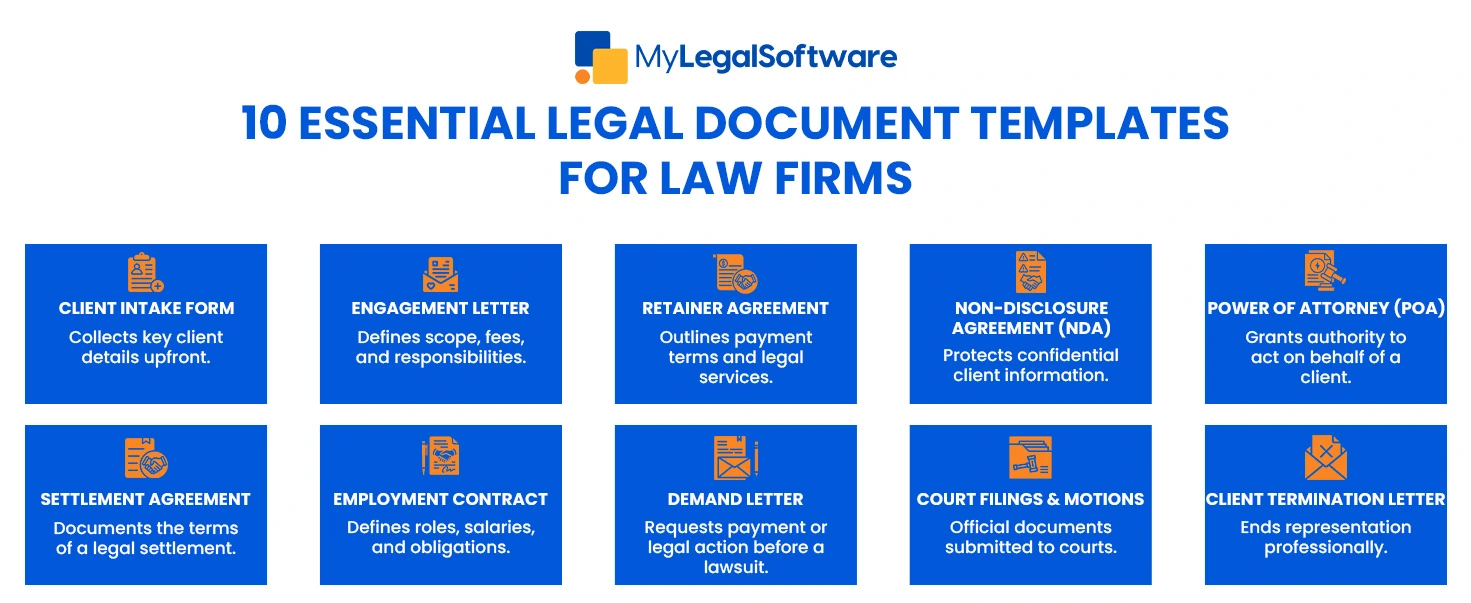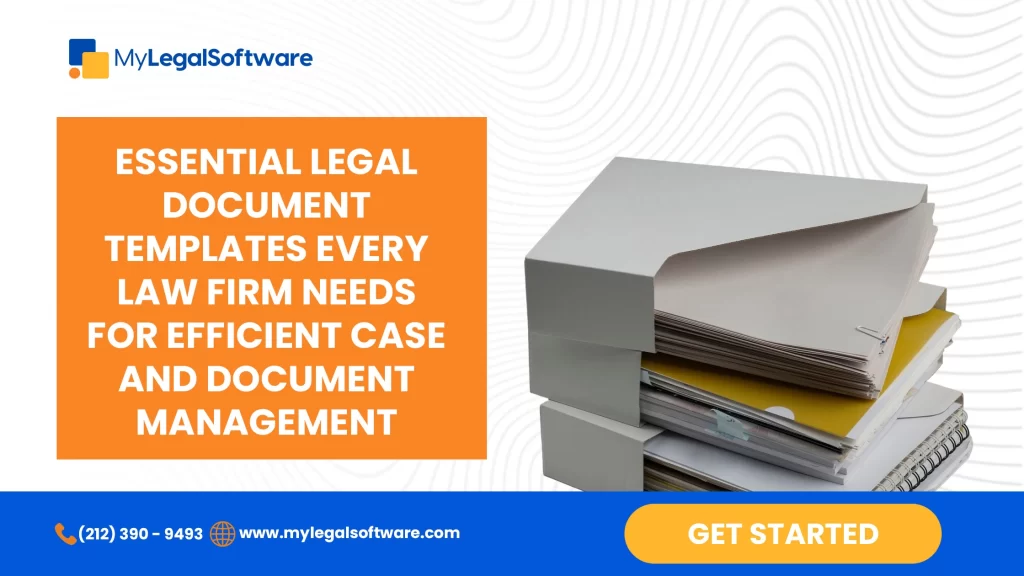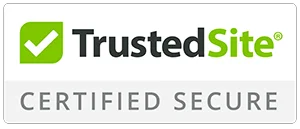Every law firm deals with an overwhelming amount of paperwork. With legal document templates and case management software, however, these law firms can now simplify the process. From client agreements to court filings, having standardized templates ensures efficiency, accuracy, and consistency.
With the right templates, you can save time, stay organized, and ensure consistency across your firm. And when combined with powerful case management tools, the entire process becomes even more efficient.
In this guide, we’ll break down the must-have legal document templates for every law firm. Let’s get started!
Why Legal Document Templates Matter
Think about how often you draft similar documents for different clients. Without templates, you’re stuck copying and pasting, making small edits, and hoping you didn’t miss anything.
Using legal document templates offers:
- Efficiency – No need to start from scratch every time.
- Consistency – Ensures all legal documents meet firm-wide standards.
- Accuracy – Reduces the risk of errors or missing critical clauses.
- Compliance – Keeps documents aligned with legal requirements.
Now, let’s explore the most essential templates your law firm should have.

- Client Intake Form
Before a case even begins, you need detailed client information. A client intake form gathers everything upfront, saving you time later.
Key Details to Include:
- Personal and contact information
- Case type and details
- Conflict of interest screening
- Initial consultation notes
With case management software, intake forms can be automated and stored digitally, ensuring easy access and seamless onboarding.
- Engagement Letter
An engagement letter sets clear expectations between you and your client. It defines the scope of work, legal fees, and responsibilities.
Why It’s Important:
- Prevents misunderstandings
- Outlines attorney-client obligations
- Clarifies billing structures
A strong engagement letter template saves time while maintaining professionalism and transparency.
- Retainer Agreement
Many law firms require clients to sign a retainer agreement before work begins. This ensures upfront payment and secures legal services.
Key Elements:
- Fee structure (hourly, flat, contingency)
- Scope of representation
- Retainer amount and replenishment terms
- Refund policies
Using document management Software, you can store signed agreements securely and retrieve them instantly when needed.
- Non-Disclosure Agreement (NDA)
Confidentiality is crucial in legal work. A non-disclosure agreement (NDA) protects sensitive information when working with clients, partners, or third parties.
When You Need It:
- Discussing confidential case details
- Partnering with external consultants
- Protecting trade secrets and proprietary information
An NDA template ensures you always have a legally sound document ready to go.
- Power of Attorney (POA)
A power of attorney grants someone the authority to act on behalf of another person in legal or financial matters.
Common Uses:
- Estate planning
- Business transactions
- Healthcare decisions
Having a POA template in your document library ensures clients can quickly authorize representation when needed.

- Settlement Agreement
When disputes are resolved out of court, a settlement agreement documents the terms and conditions.
Key Components:
- Terms of the settlement
- Payment details
- Confidentiality clauses
- Liability releases
Using case management software, you can track settlements, store agreements, and monitor compliance effortlessly.
- Employment Contracts
If your law firm hires staff, having employment contract templates is essential. These contracts outline roles, responsibilities, and terms of employment.
Important Clauses:
- Job duties and expectations
- Compensation and benefits
- Non-compete and confidentiality clauses
- Termination policies
A well-drafted template ensures compliance with labor laws while protecting your firm.
- Demand Letter
A demand letter is often the first step in resolving a legal dispute. It formally requests action or payment from the opposing party.
Why It’s Useful:
- Shows intent to take legal action
- Encourages early resolution
- Provides a written record of requests
With a demand letter template, you can draft persuasive, legally sound letters quickly.
- Court Filings and Motions
Every law firm needs templates for court filings, including:
- Motions to dismiss
- Summary judgment motions
- Complaints and responses
Having standardized legal templates ensures filings are accurate and meet court requirements.
- Client Termination Letter
Sometimes, lawyer-client relationships don’t work out. A client termination letter formally ends representation while maintaining professionalism.
What It Should Include:
- Reason for termination (if necessary)
- Final steps and outstanding fees
- Instructions for retrieving case files
This template helps law firms handle client separations smoothly.
How Case Management and Document Management Software Help
Having legal document templates is great, but managing them effectively is even better. That’s where case management software and document management tools come in.
Benefits of Using Software for Document Management:
- Easy Storage & Retrieval – Find files instantly instead of digging through paperwork.
- Automation – Generate documents with pre-filled client details.
- Security – Keep confidential files encrypted and protected.
- Collaboration – Share documents seamlessly with your team.
With MyLegalSoftware, you can organize, automate, and streamline all your firm’s legal documents in one place.
Conclusion
Having the right legal document templates saves time, improves accuracy, and boosts efficiency. Whether it’s contracts, agreements, or court filings, standardizing your documentation makes your law firm run smoother.
Pair these templates with case management software and document management tools for even greater efficiency. Ready to take your legal document management to the next level?
Try MyLegalSoftware today and experience seamless legal workflow management!
Visit MyLegalSoftware.com to learn more.
Want to learn How Legal Document Automation Can Save Your Firm Time and Money? Go here.
Frequently Asked Questions
How do legal document templates save time for law firms?
They eliminate repetitive drafting, ensure consistency, and reduce errors, allowing lawyers to focus more on legal work and less on paperwork.
What is the difference between case management and document management software?
Case management software tracks client cases, deadlines, and tasks, while document management software organizes, stores, and secures legal files.
Is MyLegalSoftware suitable for small law firms?
Absolutely! MyLegalSoftware is designed to help firms of all sizes streamline document management, improve efficiency, and enhance client service.








